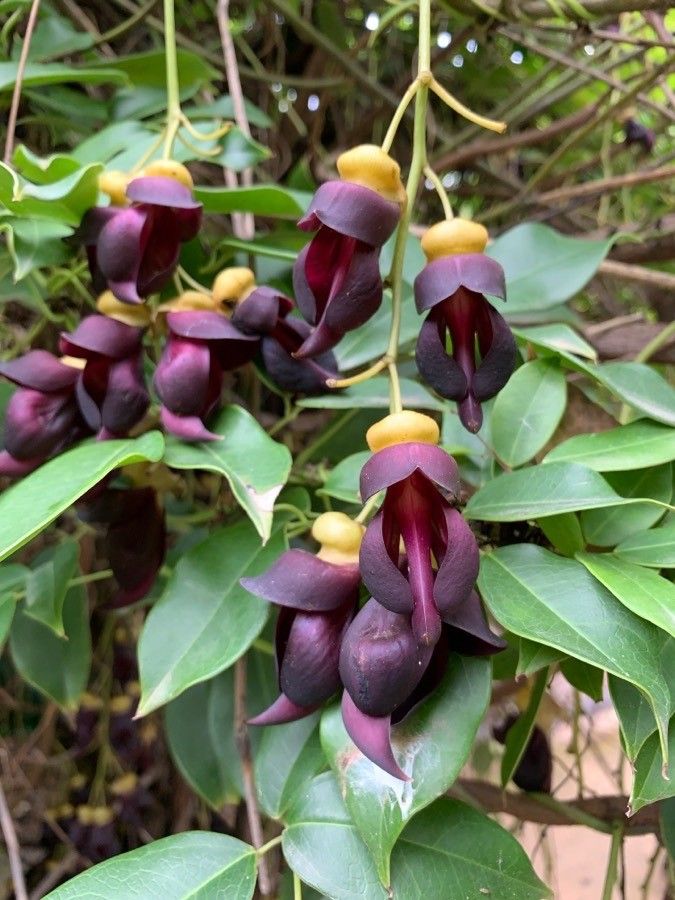Evergreen Mucuna
mucuna sempervirens
Also known as: ["Evergreen Mucuna"]
Overview
A woody vine native to East Asia, known for its persistent foliage and large, velvety pods containing seeds used in traditional medicine.
Benefits & Perks
["fast growing","wildlife attractant (bees, butterflies, birds)"]
Botanical Classification
| Phylum: | Magnoliophyta |
| Class: | Magnoliopsida |
| Order: | Fabales |
| Family: | Fabaceae |
| Genus: | Mucuna |
| Botanical Name: | Mucuna sempervirens |
Plant Characteristics
Basic Information
- Category: Shrubs
- Suitable Location: trellised or arbor location in garden, or large indoor container with support
- Suitable For:
- Is Weed: No
- Allergenicity: low
Environmental Needs
- Climate: {"temperatureRange":"10–30°C"}
- Hardiness: {"zones":"9–11"}
- Misting: rarely required, only if ambient humidity is very low
- Drainage: Fast-draining to prevent waterlogging.
- Soil Type: Well-draining, loamy soil with added organic matter.
Maintenance Level
- Maintenance Level: moderate
- Toughness Level: moderate
- Pruning Frequency: Annually in late winter or early spring before new growth begins.
- Pruning Intensity: Moderate; remove up to one-third of old growth if needed.
Care Details
Ideal Sunlight Coverage:
Bright indirect light for 6–8 hours daily; can tolerate some direct morning sun but avoid harsh afternoon sun.
Sunlight Tolerance Tips:
Acclimate slowly to direct light, protect from intense sun to prevent scorching, adjust placement based on indoor/outdoor conditions.
Care Requirements
Care Difficulty
moderatemoderate
Sunlight
partial shade to full sun
Rotate plant for even growth; use sheer curtains to filter intense light; move outdoors gradually in spring.
Watering
every 7–10 days during active growth, reduce in winter
Water thoroughly until it drains from the bottom, allow soil to dry between waterings, avoid overwatering.
Soil
well-draining, fertile loam with organic matter
pH: Slightly acidic to neutral (pH 6.0–7.0).
Use a mix of potting soil and perlite; avoid heavy clay soils; ensure pots have drainage holes.
Temperature
Prefers 65–85°F (18–29°C); tolerates mild fluctuations but avoid prolonged exposure to extremes.
Avoid sudden temperature changes; protect from drafts; maintain consistent warmth during active growth.
Fertilizing
every 4–6 weeks during growing season with balanced liquid fertilizer
Fertilize only when actively growing; flush soil occasionally to prevent salt buildup; avoid overfertilizing.
Propagation
Methods
Stem cuttings with nodes.
Step-by-Step Propagation Guide
- Take cutting, apply hormone, place in medium, maintain humidity, wait for roots.
Best Time: Spring or early summer when the plant is actively growing.
Environment
High humidity (70–90%), warm temperatures (70–75°F), indirect light.
Medium
Well-draining mix of peat and perlite or cactus mix.
Hormone
Recommended to promote root development.
Timeline
Roots in 3–6 weeks; establish in 2–3 months.
Tools Needed
Pruners, rooting hormone, small pots, plastic bags or propagator.
Quick Tips
Use healthy, non-flowering stems; keep consistently moist but not waterlogged; provide bottom heat if possible.
Pruning & Repotting
Pruning Guide
Method
Selective cutting of stems to maintain form and vigor.
Pruning Plan
Shape the plant, encourage bushier growth, remove dead or overgrown stems.
Tools
Clean, sharp pruners or scissors.
Checklist
Disinfect tools, prune above nodes, remove dead/damaged growth, shape evenly.
Repotting Guide
Best Season
Spring, when the plant is entering active growth.
Pot Size
Choose a pot one size larger (1–2 inches wider) with drainage holes.
Method
Remove gently, trim roots if needed, place in fresh soil, water lightly, avoid direct sun for a few days.
Suggestions
Repot every 2–3 years or when roots fill the pot; promotes fresh soil and space for growth.
Checklist
Check root bound status, prepare new pot, trim roots, use fresh soil, water lightly.
Advanced Care Tips
Watering Mastery
Watering Checklist
Check soil moisture, water thoroughly, ensure drainage, adjust for season.
How to Apply Water Properly
Water directly at the root zone, ensure water penetrates deeply, allow excess to drain, water in the morning to reduce evaporation.
Watering Schedule Tips
Water deeply once the top inch of soil feels dry; reduce frequency in winter to prevent root rot.
Soil Improvement
Add perlite or sand for drainage, incorporate compost for fertility, ensure good aeration.
Temperature Stress Management
Signs of Temperature Issues
Yellowing leaves, leaf drop, stunted growth, or bud drop.
Cold Stress
Slows growth, may cause leaf discoloration or dieback in prolonged cold.
Solution: Move to a warmer location, insulate pots, avoid cold drafts, protect from frost.
Hot Stress
Wilting, leaf scorch, or reduced vigor in excessive heat.
Solution: Provide shade, increase humidity, water more frequently, ensure good air circulation.
Fertilizing Guide
Fertilizing Checklist
Check growth phase, dilute fertilizer, apply to moist soil, avoid contact with leaves.
Fertilizing Method
Use balanced liquid fertilizer diluted to half strength every 4–6 weeks during growing season (spring/summer); cease in fall/winter.
Common Problems & Solutions
Toxicity Warning
Cats
ToxicCats are highly sensitive to the L-dopa found in Mucuna sempervirens. Ingestion of seeds or pods can result in severe neurological and gastrointestinal toxicity, potentially leading to life-threatening conditions.
⚠️ Symptoms:
🌿 Toxic Parts:
⚡ Toxic If:
if eaten
Dogs
ToxicThe seeds and pods of Mucuna sempervirens are toxic to dogs due to their high L-dopa content. Ingestion can lead to severe gastrointestinal upset and neurological symptoms, which may require immediate veterinary intervention.
⚠️ Symptoms:
🌿 Toxic Parts:
⚡ Toxic If:
if eaten
Humans
ToxicMucuna sempervirens contains high levels of L-dopa, a precursor to dopamine, which can cause severe neurological and gastrointestinal disturbances when ingested. The plant's seeds and pods are particularly concentrated in this compound, leading to potential toxicity even in small quantities.
⚠️ Symptoms:
🌿 Toxic Parts:
⚡ Toxic If:
if eaten
Frequently Asked Questions
Q: Is Mucuna sempervirens toxic to pets?
A: Reliable information on toxicity to pets is not available.
Q: How fast does Mucuna sempervirens grow?
A: It is considered a fast-growing vine.
Q: Does Mucuna sempervirens attract wildlife?
A: Yes, it attracts bees, butterflies, and birds.
Quick Reference
| Family: | Fabaceae |
| Care: | moderate |
| Light: | partial shade to full sun |
| Water: | every 7–10 days during activ |
Get Expert Care Tips
Download the Plantious app for personalized care reminders and plant identification!
Google Play App Store






